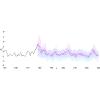当前位置:
X-MOL 学术
›
Phys. Rev. E
›
论文详情
Our official English website, www.x-mol.net, welcomes your
feedback! (Note: you will need to create a separate account there.)
Correspondence between temporal correlations in time series, inverse problems, and the spherical model.
Physical Review E ( IF 2.2 ) Pub Date : 2020-07-06 , DOI: 10.1103/physreve.102.012112 Riccardo Marcaccioli 1 , Giacomo Livan 1, 2
Physical Review E ( IF 2.2 ) Pub Date : 2020-07-06 , DOI: 10.1103/physreve.102.012112 Riccardo Marcaccioli 1 , Giacomo Livan 1, 2
Affiliation

|
In this paper we employ methods from statistical mechanics to model temporal correlations in time series. We put forward a methodology based on the maximum entropy principle to generate ensembles of time series constrained to preserve part of the temporal structure of an empirical time series of interest. We show that a constraint on the lag-one autocorrelation can be fully handled analytically and corresponds to the well-known spherical model of a ferromagnet. We then extend such a model to include constraints on more complex temporal correlations by means of perturbation theory, showing that this leads to substantial improvements in capturing the lag-one autocorrelation in the variance. We apply our approach on synthetic data and illustrate how it can be used to formulate expectations on the future values of a data-generating process.
中文翻译:

时间序列中的时间相关性,反问题和球形模型之间的对应关系。
在本文中,我们采用统计力学的方法对时间序列中的时间相关性进行建模。我们提出了一种基于最大熵原理的方法来生成时间序列集合,这些集合被约束为保留感兴趣的经验时间序列的时间结构的一部分。我们表明,滞后一自相关的约束可以完全解析地处理,并且对应于众所周知的铁磁体的球形模型。然后,我们通过扰动理论扩展了该模型,以包含对更复杂的时间相关性的约束,这表明在捕获方差中的滞后一自相关时,这导致了实质性的改进。我们将我们的方法应用于合成数据,并说明如何将其用于对数据生成过程的未来价值制定期望。
更新日期:2020-07-06
中文翻译:

时间序列中的时间相关性,反问题和球形模型之间的对应关系。
在本文中,我们采用统计力学的方法对时间序列中的时间相关性进行建模。我们提出了一种基于最大熵原理的方法来生成时间序列集合,这些集合被约束为保留感兴趣的经验时间序列的时间结构的一部分。我们表明,滞后一自相关的约束可以完全解析地处理,并且对应于众所周知的铁磁体的球形模型。然后,我们通过扰动理论扩展了该模型,以包含对更复杂的时间相关性的约束,这表明在捕获方差中的滞后一自相关时,这导致了实质性的改进。我们将我们的方法应用于合成数据,并说明如何将其用于对数据生成过程的未来价值制定期望。











































 京公网安备 11010802027423号
京公网安备 11010802027423号